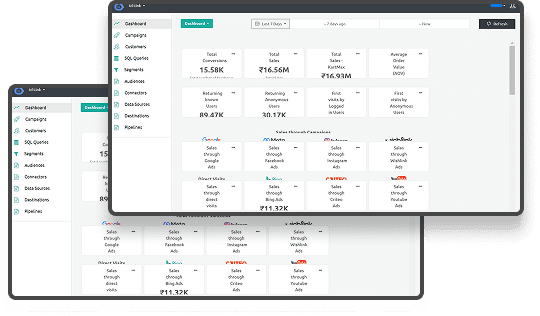Understanding the Importance and Meaning of Conversion Attribution
When it comes to optimizing your marketing efforts, understanding conversion attribution is one of the most crucial steps you can take.
Conversion attribution is one of the most effective ways to achieve this insight. This concept refers to identifying which marketing touchpoints, campaigns, or channels contributed to a specific customer action or conversion.
By accurately measuring and analyzing conversion attribution, businesses can make more informed decisions, optimize their marketing strategies, and allocate resources more effectively.
In this blog, we will explore the meaning of conversion attribution, why it's essential for improving marketing strategies, and how to effectively use it to optimize your campaigns.
To begin, let’s explore the concept of conversion attribution and understand how it helps businesses identify which touchpoints contribute to conversions.
What is Conversion Attribution?
Conversion attribution refers to the process of assigning credit to the various touchpoints in a customer’s journey that lead to a conversion. A "conversion" can mean anything from a customer completing a purchase, signing up for a newsletter, or downloading an ebook. Conversion attribution allows you to understand the role of each interaction your customer has with your brand before they take the desired action.
Different attribution models give credit in different ways:
1. First-Touch Attribution:
This model assigns 100% of the credit to the first interaction a customer has with your brand, such as an initial click on an ad or social media post. It assumes that the first touchpoint was the primary driver of the conversion.
2. Last-Touch Attribution:
In this model, 100% of the credit is given to the final touchpoint before conversion, which could be the last ad they clicked or the last website they visited before purchasing.
3. Linear Attribution:
Linear attribution gives equal credit to every touchpoint a customer interacts with before converting, offering a more balanced view of how each touchpoint contributes to the final outcome.
4. Time-Decay Attribution:
This model gives more credit to touchpoints that are closer in time to the conversion. For example, the final ad interaction before a purchase gets more credit than an interaction that happened a week ago.
5. Position-Based Attribution (U-Shaped):
This model assigns the most credit to the first and last touchpoints, with the middle touchpoints receiving a smaller portion of the credit.
By understanding which touchpoints in your customer journey lead to conversions, you can optimize your marketing strategy to focus on the channels that are driving the best results.
Related Read: Understanding Multi-Channel Attribution and Its Basics
Now that we’ve covered the basics, let’s discuss why conversion attribution is crucial for optimizing marketing campaigns and boosting ROI.
Why is Conversion Attribution Important?
Conversion attribution plays a critical role in how you optimize your marketing campaigns, improve ROI, and maximize your marketing budget. Below are some of the key reasons why it is essential:
1. Understanding Campaign Performance: Conversion attribution provides valuable insights into how your campaigns are performing across different channels. It helps you see which channels or touchpoints are contributing the most to conversions and which ones need improvement. For example, if your paid search ads are driving the most conversions, but your social media efforts aren’t performing well, you can adjust your strategy to allocate more resources to paid search.
2. Efficient Budget Allocation: When you understand the channels that are bringing in the most conversions, you can reallocate your budget accordingly. Instead of spending money on underperforming campaigns, you can focus on the touchpoints that yield the best results, thus improving your overall marketing ROI.
3. Enhancing Customer Journey Insights: With conversion attribution, you can track a customer’s entire journey, not just the final interaction. This helps you better understand how different touchpoints influence the decision-making process. By knowing which touchpoints are most effective, you can streamline the customer journey and create a more seamless, personalized experience for your audience.
4. Increasing Cross-Channel Efficiency: Many customers interact with multiple touchpoints before converting. By utilizing conversion attribution, you can gain a comprehensive view of cross-channel performance. Whether it's email, social media, or paid search, attribution allows you to see how your different marketing channels work together to drive conversions. This cross-channel insight allows for more effective campaigns and resource allocation.
5. Boosting Customer Retention: Attribution models help you understand which touchpoints contribute to both acquiring new customers and retaining existing ones. Once you know which interactions lead to higher customer lifetime value, you can focus your marketing efforts on optimizing those areas to retain customers for longer.
Now that we understand its importance, let’s look into how you can use conversion attribution data to optimize your marketing strategies.
How to Use Conversion Attribution to Optimize Marketing Campaigns
Knowing conversion attribution is important, but using it to optimize your marketing campaigns is where the real value lies. Here’s how you can use attribution data to refine your strategies:
1. Identify High-Performing Channels: By analyzing your attribution data, you can identify which marketing channels are performing the best. If a particular channel, like email marketing or social media, is consistently driving conversions, you can allocate more of your marketing budget to these channels. Similarly, you can cut back on channels that aren’t delivering results.
2. Optimize the Customer Journey: Conversion attribution helps you understand how customers interact with your brand before making a purchase. Use this information to optimize the customer journey and make it more efficient. For example, if your attribution model shows that customers who engage with email campaigns and social media before purchasing have higher conversion rates, focus on integrating your email and social media efforts to drive higher conversions.
3. A/B Test Your Marketing Efforts: Attribution helps you measure the effectiveness of your A/B tests by showing you which variations of an ad, landing page, or email drive the most conversions. Running A/B tests with different creatives and tracking their impact on conversions will help you refine your messaging and creative strategy. This continuous improvement process is vital for optimizing your marketing ROI.
4. Personalize Your Marketing: Use attribution data to personalize your marketing efforts. For instance, if you know that certain customer segments tend to convert after receiving targeted email campaigns or interacting with specific social media content, you can create more tailored campaigns for these segments. By personalizing content, you can increase the likelihood of conversion.
Explore more: Understanding Multi-Touch vs. Last-Touch Attribution
5. Measure Success Beyond Clicks: Conversion attribution allows you to measure success beyond basic metrics like clicks or impressions. By tracking conversions, you gain a deeper understanding of the effectiveness of your campaigns. This comprehensive view lets you assess how well your ads, content, and channels work together to drive results. By focusing on conversions instead of just clicks, you ensure that your marketing strategy is geared toward long-term success.
Learn more about: Track the Customer Journey Across Multiple Channels with Ingest Labs
With the right approach in place, let’s take a look at how Ingest Labs can assist in streamlining your conversion attribution efforts for better results.
How Ingest Labs Can Help with Conversion Attribution
Ingest Labs offers a suite of tools that help businesses track, manage, and optimize conversion attribution with ease. With server-side tagging, Ingest Labs ensures that your marketing data is collected securely and accurately, without being reliant on third-party cookies. This ensures compliance with privacy regulations like GDPR, while still providing in-depth attribution insights.
With real-time data streaming and analytics, Ingest Labs gives you up-to-the-minute insights into how your marketing campaigns are performing across various touchpoints. The platform integrates with over 100+ marketing tools, enabling seamless data sharing and centralized management. This unified approach allows you to track conversions across different platforms and channels, making it easier to understand the full customer journey.
Whether you’re using first-touch, last-touch, or multi-touch attribution models, Ingest Labs provides the tools you need to gain a comprehensive view of your marketing performance. By using their platform, you can optimize your campaigns for better ROI, ensuring that every dollar spent brings in the best possible return.
Conclusion
Understanding and using conversion attribution is essential for any business looking to optimize its marketing efforts. By tracking and measuring the impact of each touchpoint in the customer journey, you can allocate resources more effectively, improve your strategies, and ultimately increase your ROI. Whether you’re using first-touch, last-touch, or multi-touch attribution, conversion attribution helps you make more data-driven decisions that result in better marketing performance.
With Ingest Labs, you can streamline your conversion attribution efforts and gain deeper insights into the effectiveness of your campaigns. By integrating attribution into your marketing strategy, you’ll be able to create more personalized experiences, improve customer retention, and maximize your marketing spend. Ready to take control of your conversion attribution and drive better results, Contact us today and discover how Ingest Labs can help you optimize every step of your marketing journey.






